Are you tired of the disarray in your refrigerator, with shelves out of place and items scattered about?
If so, we’ve got you covered. The simple act of rearranging shelves in your refrigerator can help maximize storage space.
In this article, we’ll guide you through the steps to efficiently put your refrigerator shelves back in place. Keep your food fresh and easy to access with a well-organized fridge.
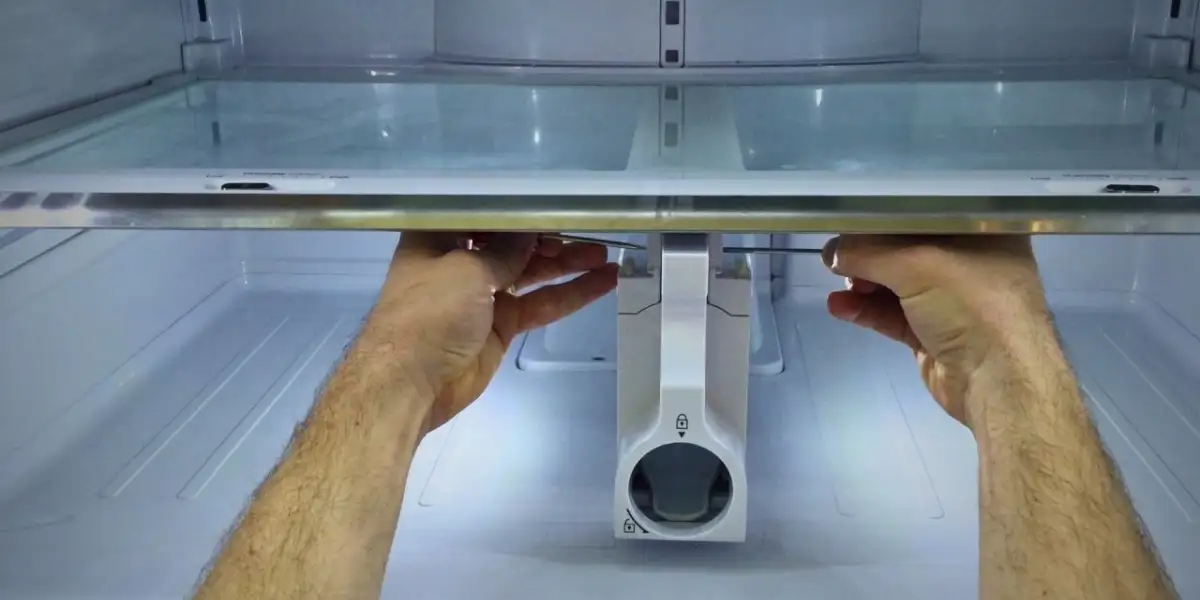
How to Put Shelves Back in Your Refrigerator?
Here is how you can put shelves back into your refrigerator in the easiest way possible.
Step 1: Clear the Refrigerator Shelves
The first step to putting shelves back in your refrigerator is to clear them of any items.
Remove all the food containers, jars, and bottles from the refrigerator to create space for the shelves.
Step 2: Examine the Shelf Layout
Take a moment to examine the layout and arrangement of the refrigerator shelves. Refrigerators differ in size and configuration, so you should understand yours.
Note the number of shelves, their sizes, and any adjustable features that might be present.
Step 3: Clean the Shelves
Before reinserting the shelves, it’s crucial to clean them thoroughly. Wipe spills, stains, and debris away with a mild detergent or warm water and baking soda.
Rinse the shelves with water and dry them completely before proceeding.
Step 4: Determine the Shelf Positions
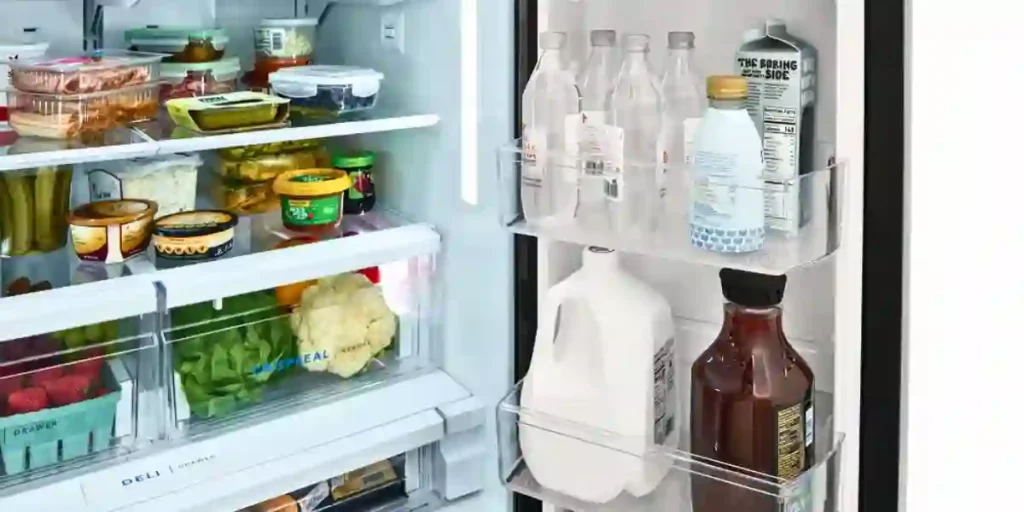
Decide on the positions of the shelves based on your storage needs. You may want to adjust the shelf heights to accommodate taller or larger items.
Organize the shelves to maximize space and create a logical system for storing food.
Step 5: Insert the Shelves
Align the bottom shelf with the grooves inside the refrigerator starting at the bottom. Ensure that it sits securely and is level.
Slowly push the shelf into place until it is fully inserted. Repeat this process for each remaining shelf, working your way from the bottom to the top.
Step 6: Test Stability and Adjust as Needed
Once all the shelves are back in place, gently test their stability by applying light pressure.
Make sure they can support the weight of the items you typically store on them.
If any shelves feel unstable or wobbly, double-check their alignment and adjust them accordingly.
Some refrigerators have additional locking mechanisms or clips to secure the shelves further.
Step 7: Return Food Items
With the shelves securely in place, it’s time to return the food items to the refrigerator.
Organize the items neatly and efficiently, taking advantage of the new shelf arrangement.
Group similar items together and use bins or containers to keep things organized.
Step 8: Clean the Exterior
As a finishing touch, don’t forget to clean the exterior of the refrigerator. Using a mild cleaner or a vinegar-water solution, wipe down doors, handles, and other surfaces.
This step will help maintain a clean and hygienic refrigerator.
Benefits of Properly Organized Refrigerator Shelves
Here are some advantages of having well-arranged refrigerator shelves:
Enhanced Visibility:
When your refrigerator shelves are properly organized, it becomes easier to see and locate items.
Food items that are similar can be grouped together so you can easily identify what you have. This saves you time and reduces food waste.
Maximizing Space:
Efficiently organizing the shelves allows you to maximize the available space in your refrigerator.
By utilizing the vertical space and adjusting shelf heights, you can accommodate items of varying sizes.
Better air circulation prevents overcrowding and maintains optimal refrigerator cooling.
Improved Food Safety:
Proper organization of shelves promotes food safety. A specific shelf for raw meat, dairy, fruits, and vegetables prevents cross-contamination.
This reduces the risk of foodborne illnesses and ensures the freshness and quality of your food.
Easy Maintenance and Cleaning:

Well-organized shelves make cleaning and maintenance tasks more manageable.
Organize items neatly so you can remove shelves for cleaning or wipe spills and crumbs easily.
Prevents bacteria growth and unpleasant smells by maintaining a clean and hygienic environment.
Extended Shelf Life:
When you organize your refrigerator shelves effectively, it helps extend the shelf life of your food.
Freshness can be preserved by keeping perishable items in designated areas at the right temperature.
This can save you money by reducing food waste and the need for frequent grocery shopping.
Stress-Free Meal Preparation:
With well-organized shelves, meal preparation becomes more efficient and less stressful.
The refrigerator is organized so that ingredients, condiments, and leftovers are found quickly.
This promotes a smoother cooking process and allows you to enjoy more time spent preparing meals.
Customized Storage Solutions:
Your refrigerator shelves can be organized properly to create customized storage solutions.
You can use containers, bins, or dividers to separate and group similar items together.
As a result, items are easier to retrieve and access, improving convenience overall.
Factors to Consider When Placing Shelves in Your Refrigerator
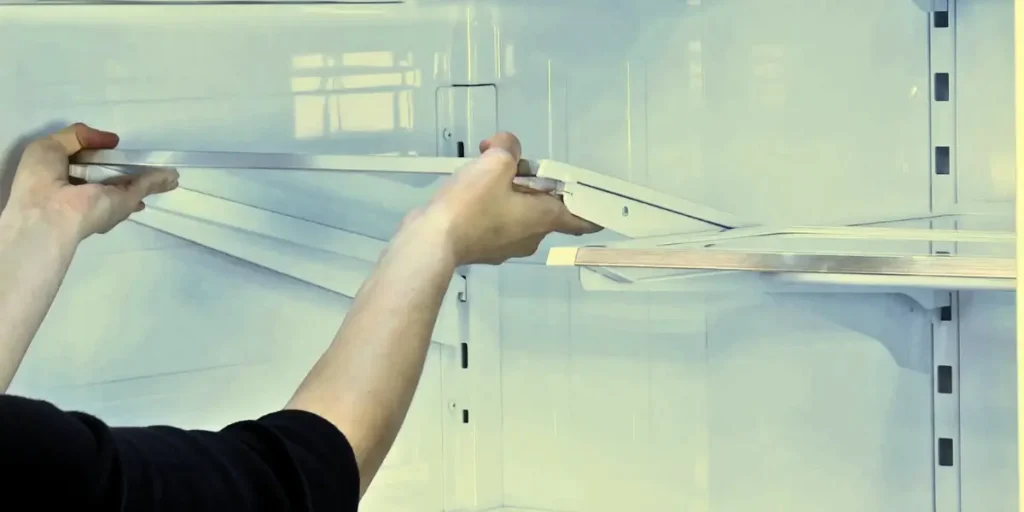
To ensure optimal organization and functionality of your refrigerator, consider the following factors:
Height Adjustability:
Check if your refrigerator shelves are adjustable in height. To accommodate items of varying sizes, you can customize the spacing between shelves.
Make sure your shelves are adjusted according to the height of your most frequently stored items.
Temperature Zones:
Refrigerators often have temperature variations throughout different zones. Take note of these temperature variations and strategically place shelves accordingly.
It’s best to keep upper shelves cold and lower shelves slightly warmer in the refrigerator.
Weight Capacity:
Each refrigerator shelf has a weight capacity that it can safely hold.
Make sure you don’t overload shelves with heavy items, as this could compromise their stability. Consider placing heavier items on lower shelves for added support.
Organization and Accessibility:
Think about how you want to organize your food items for easy access. Sort shelves by food categories, like meat, dairy, beverages, condiments, and leftovers.
Consider placing frequently used items within easy reach to avoid unnecessary bending or reaching.
Air Circulation:
Proper air circulation is crucial for maintaining consistent cooling throughout the refrigerator.
Avoid overcrowding shelves or blocking the vents with items. The refrigerator stays cool by allowing cool air to circulate between items.
Fragile Items and Spill Containment:
Place fragile or delicate items on shelves where they won’t be bumped or jostled. Items and shelves with lips or a containment feature will prevent spills from spreading.
Utilizing Door Shelves:
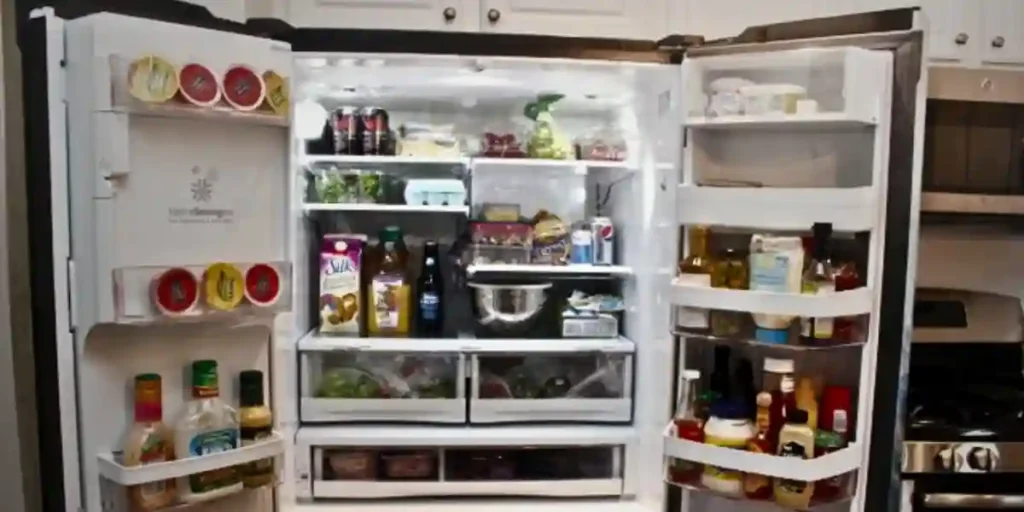
Many refrigerators have door shelves that are ideal for storing condiments, jars, and small bottles.
Keep in mind the weight limitations of these shelves and use them for lighter items. Arrange the door shelves in a way that allows for easy access to frequently used items.
Cleaning and Maintenance:
Consider how easily you can remove and clean the shelves when necessary. Opt for shelves that are easy to remove and reinsert without hassle.
Choose materials that are simple to wipe clean and resistant to stains and odors.
Comparing Different Shelf Arrangements for Refrigerator Organization
Here are some shelf arrangements to help you decide which is best:
Standard Shelf Arrangement:
In a standard shelf arrangement, shelves are evenly spaced from top to bottom. Using this arrangement, you can distribute space evenly between items of different sizes.
It allows for flexibility in adjusting shelf heights as needed. It may not optimize space usage if you have a specific need for taller or shorter shelf areas.
Customized Height Arrangement:
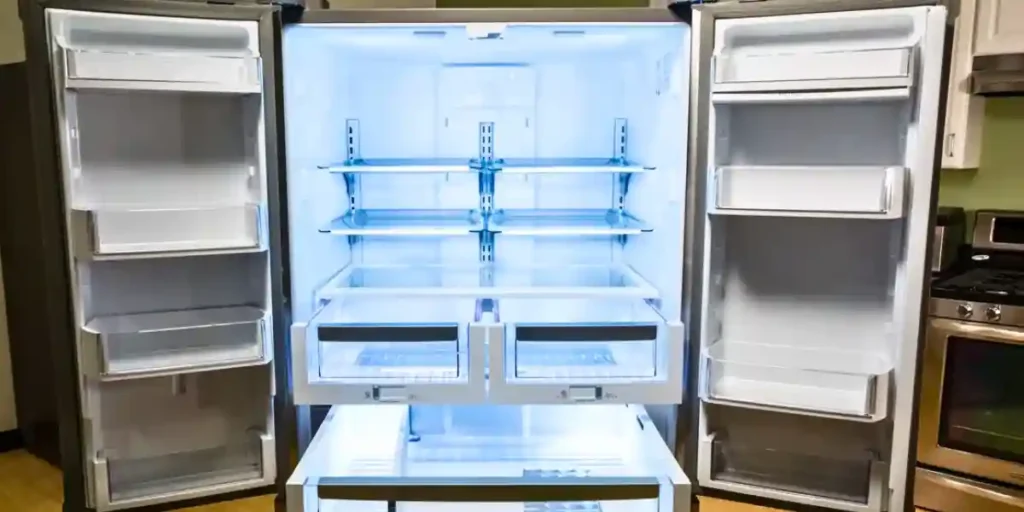
A customized height arrangement involves adjusting shelf heights to accommodate specific items.
When you have taller or bulkier items that need more vertical space, this arrangement works well.
If you remove a shelf or raise a shelf, you can create a dedicated space for items like large bottles.
Categorized Shelf Arrangement:
A categorized shelf arrangement involves designating specific shelves for different food categories.
You could reserve one shelf for dairy products, one for meats, and one for fruits and vegetables.
This arrangement promotes better organization and makes it easier to locate specific items.
Furthermore, it prevents cross-contamination and reduces the risk of spills or leaks spreading.
Priority Placement Arrangement:
Place frequently used items on the most accessible shelves in a priority placement arrangement.
Items you use daily, like beverages, condiments, and snacks, should be easily accessible.
You can place less frequently used items higher or lower, like specialty ingredients.
This arrangement ensures convenience and minimizes the need to search for commonly used items.
Temperature-Sensitive Arrangement:
Consider arranging shelves based on temperature zones within your refrigerator.
Items that require colder temperatures, like dairy products and raw meat, should be kept higher.
Place fruits, vegetables, and less temperature-sensitive items on lower shelves to keep them colder.
This arrangement helps optimize the freshness and longevity of different food types.
Containerized and Stacked Arrangement:
Using containers or bins can provide an additional layer of organization within your refrigerator.
Containers help you organize similar items and prevent them from dispersing. Stackable containers maximize storage space and improve shelf utilization.
This arrangement works well for items like deli meats, cheese, or small jars.
Maintaining Clean and Functional Refrigerator Shelves
Here are some tips to help you keep your refrigerator shelves clean and in good working condition:
Regular Cleaning:
Make it a habit to clean your refrigerator shelves regularly. To clean the shelves, remove all items and use a mild detergent or warm water and baking soda.
Pay attention to spills, stains, and crumbs, and wipe them away with a soft cloth or sponge.
Make sure the shelves are completely dry before placing them back in the fridge.
Remove and Clean Spills Immediately:
If you see spills or leaks, remove them from the shelves and clean the mess up as soon as possible.
This prevents odors, bacteria growth, and cross-contamination. Use a clean cloth or paper towel to absorb the spill and wipe the area with a mild cleaning solution.
Ensure that the shelves are dry before returning the items to their respective places.
Organize and Rotate Items:
Keep your refrigerator organized in a way that promotes accessibility and prevents overcrowding.
Avoid stacking items too tightly, as this can impede air circulation and cause uneven cooling.
Rotate items and place newer purchases behind older ones using the “first in, first out” method.
This helps prevent food waste and ensures that perishable items are used before they expire.
Use Shelf Liners or Mats:
Consider using shelf liners or mats to protect your refrigerator shelves from spills and stains.
These liners can be easily removed and cleaned, providing an extra layer of protection.
Opt for liners that are easy to wipe clean and resistant to moisture. Remember to replace them periodically to maintain cleanliness and hygiene.
Check for Damaged or Worn-out Shelves:
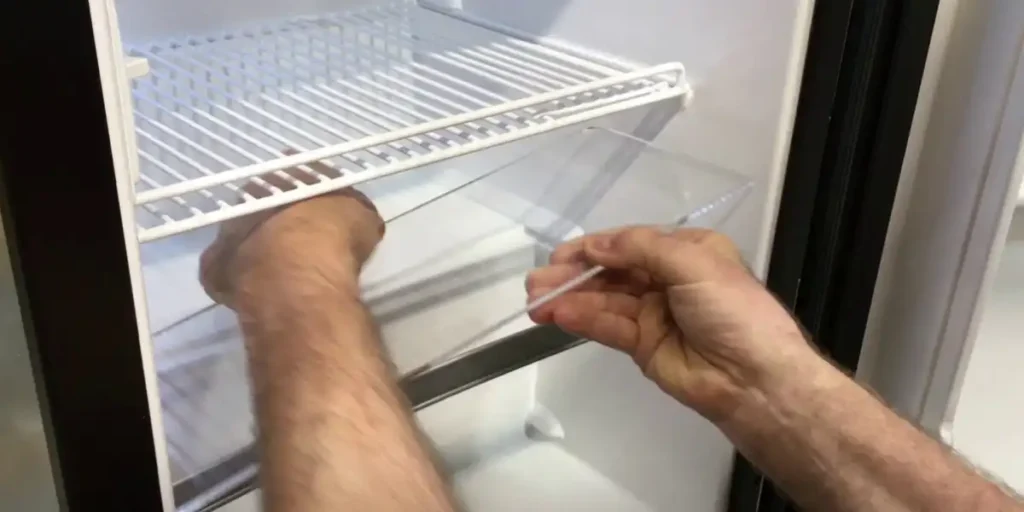
Check your refrigerator shelves frequently for damage, such as cracks, chips, or warping.
Damaged shelves can compromise their stability and potentially cause accidents or spills.
If you notice any issues, contact the manufacturer or retailer to inquire about replacement options.
Maintain Temperature and Airflow:
Ensure that your refrigerator is set to the appropriate temperature to keep food fresh and safe. Ensure the temperature settings are accurate by using a refrigerator thermometer.
The cooling process can be disrupted if items on shelves block vents or air channels. To prevent hot spots and maintain consistent temperatures, maintain proper airflow.
Avoid Overloading Shelves:
Be mindful of the weight capacity of your refrigerator shelves and avoid overloading them.
Shelves can sag or break when overloaded, potentially damaging the items stored on them. Consider moving heavier items to the lower shelves to add stability.
Frequently Asked Questions About Putting Shelves Back in Your Refrigerator
Can I Adjust The Height Of The Shelves In My Refrigerator?
Adjustable shelves are available on many refrigerators so you can customize the height. Check your refrigerator’s user manual or inspect the shelf brackets for adjustable features.
If your refrigerator doesn’t have adjustable shelves, you will need to work with the existing fixed heights.
Can I Put The Shelves Back In The Refrigerator While They Are Still Wet?
It is best to allow the shelves to dry completely before putting them back in the refrigerator.
Wet shelves can lead to moisture buildup and potentially cause odors or mold growth. Ensure the shelves are thoroughly dried to maintain a clean and hygienic environment.
How Should I Organize The Items On The Shelves After Putting Them Back In The Refrigerator?
Organize the items based on your preferences and storage needs. Consider grouping similar items together and placing frequently used items within easy reach.
Designate specific shelves for different food categories, such as dairy, meats, fruits, and vegetables. Use containers or bins to keep items organized and easily accessible.
Can I Put Hot Items Directly Onto The Refrigerator Shelves?
It is generally not recommended to put hot items directly onto refrigerator shelves. Items that raise the refrigerator’s internal temperature can affect other foods’ freshness and safety.
Allow hot items to cool to room temperature before placing them in the refrigerator.
Conclusion
With these simple steps, you can effortlessly put the shelves back in your refrigerator.
Then you’ll have a clean and functional fridge that maximizes space and enhances visibility.
Take charge of your refrigerator’s organization and enjoy the benefits. Keep your food fresh and accessible with a hassle-free storage system.
Start putting those shelves back in and enjoy the organized wonders of your refrigerator!
